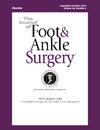Concomitant osteochondral lesion of the talus in ankle instability: Utilizing clinical presentation to guide imaging decision
IF 1.3
4区 医学
Q2 Medicine
引用次数: 0
Abstract
Low ankle sprains are a prevalent issue, often involving the anterior talofibular ligament. While there is increased attention placed on ligamentous injuries in ankle sprains, concomitant cartilaginous injuries are frequently overlooked. This article aims to (Park et al., 2021) evaluate the significance of magnetic resonance imaging in anterior talofibular ligament injuries to detect concurrent osteochondral lesions of the talus as well as other associated ligamentous injuries; (Hølmer et al., 1994) determine the importance of clinical presentation and its association with the risk of concomitant osteochondral lesions in anterior talofibular ligament injuries. We conducted a retrospective analysis of 129 patients who underwent anterior talofibular ligament reconstruction, reviewing patient data to assess the incidence of osteochondral lesions of the talus and associated ligamentous injuries. Clinical presentations were then reviewed to identify signs and symptoms associated with the occurrence of osteochondral lesions of the talus. The results indicated that calcaneofibular ligament was most injured in association with anterior talofibular ligament injuries (69.52 %; n = 73). Furthermore. 31.78 % (n = 41) of patients with anterior talofibular ligament injuries had concurrent osteochondral lesion of the talus. Analysis on clinical presentation revealed statistical significance (p < .001) between patients that had ankle joint line tenderness lasting for more than 6 weeks and the occurrence of osteochondral lesions of the talus. This study concludes that magnetic resonance imaging could be beneficial in anterior talofibular ligament injuries with patients exhibiting persistent joint line tenderness to evaluate for osteochondral lesions to ensure a comprehensive pre-operative assessment.
踝关节不稳定时并发的距骨骨软骨损伤:利用临床表现指导成像决策。
低位踝关节扭伤是一种常见疾病,通常涉及距腓骨前韧带。虽然人们越来越关注踝关节扭伤中的韧带损伤,但同时存在的软骨损伤却经常被忽视。本文旨在[1]评估磁共振成像在距骨胫骨前韧带损伤中检测并发距骨骨软骨损伤及其他相关韧带损伤的意义;[2]确定临床表现的重要性及其与距骨胫骨前韧带损伤并发骨软骨损伤风险的关联。我们对 129 例接受距骨胫骨前韧带重建术的患者进行了回顾性分析,回顾患者数据以评估距骨骨软骨损伤和相关韧带损伤的发生率。然后对临床表现进行回顾,以确定与发生距骨骨软骨损伤相关的体征和症状。结果表明,与距骨胫骨前韧带损伤相关的损伤中,以距骨胫骨韧带损伤最多(69.52%;n=73)。此外。31.78%(n=41)的距腓前韧带损伤患者同时伴有距骨骨软骨损伤。对临床表现的分析表明,该结果具有统计学意义(P
本文章由计算机程序翻译,如有差异,请以英文原文为准。
求助全文
约1分钟内获得全文
求助全文
来源期刊

Journal of Foot & Ankle Surgery
ORTHOPEDICS-SURGERY
CiteScore
2.30
自引率
7.70%
发文量
234
审稿时长
29.8 weeks
期刊介绍:
The Journal of Foot & Ankle Surgery is the leading source for original, clinically-focused articles on the surgical and medical management of the foot and ankle. Each bi-monthly, peer-reviewed issue addresses relevant topics to the profession, such as: adult reconstruction of the forefoot; adult reconstruction of the hindfoot and ankle; diabetes; medicine/rheumatology; pediatrics; research; sports medicine; trauma; and tumors.
 求助内容:
求助内容: 应助结果提醒方式:
应助结果提醒方式:


